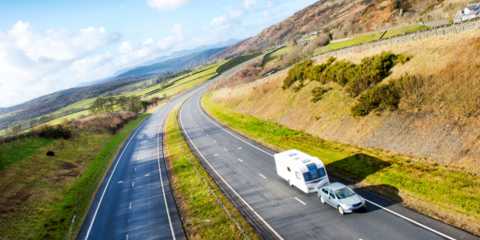
Towing Safely — Everything You Need to Know
Essential information on preparing safe towing
There could be many reasons why you want to hitch something up to the back of your car - a late summer break with your caravan, perhaps, or some transport for your bikes or boat? Whatever your reason for towing, and however new you are to pulling a load with your car, we’d strongly recommend brushing up on the rules before you head off to make sure that you’re towing safely.
What can you tow?
The legal weight of the trailer that you’re hitching to your car depends on the date you passed your driving test, believe it or not.
If you passed your test before 1997…
If you got your driving licence before 1 January 1997, you’re legally allowed to tow with a Maximum Authorised Mass of 8.5 tonnes. This mass includes the weight of your car, the weight of the trailer, and the trailer’s contents added together.
If you passed your test after 1997…
For those that passed their test after January 1st 1997, the Maximum Authorised Mass comes down to 3.5 tonnes. However, if your tow car weighs in at 3.5 tonnes already, this can increase to 4.5.
What does your car need in order to tow?
Getting your car ready to tow goes beyond fitting a universal towbar, hitching up and hitting the road. Here’s what considerations you need to make in order to safely tow:
Towbar
Choosing the right towbar for your car and the trailer it will be pulling is essential, and while you can get universal towbars, you need to make sure the one you choose doesn’t interfere with any parking sensors that the car has. We’d therefore recommend that you visit a reputable tow bar fitter, who can advise you on the best equipment for your car.
Whatever tow bar you choose, if your vehicle was manufactured after 1998, it will need to be fitted with a European Type Approved towbar.
Mirrors
Did you know that it’s an offence not to fit extendable mirrors to your car in order to see the load you’re carrying and the road behind it? Fit extendable mirrors to the existing door mirrors on your car in order to get a full view of everything behind you.
Safe and secure load
The load needs to be compatible with the weight of the car that you’re towing with, with no loose parts that are liable to come off at high speeds, or sharp edges that could cause harm.
What does your trailer need in order to be towed?
Trailer brakes
If the weight of your trailer and its contents combined weighs in at over 750KG, you’ll need to have a fully operational braking system installed onto the trailer itself, so the load isn’t reliant on the car’s brakes alone.
Number plate
In order for your trailer to be legal, it needs to have a visible number plate, and it will almost always match the registration of the tow car. It needs to be a properly manufactured number plate that meets legal requirements, which means that you cannot handwrite it.
The plate needs to be seen in the dark too, so there should be a light installed above it to illuminate it at night or in bad weather.
Lights
Talking of lights, a number plate illumination isn’t the only one your trailer needs. Regardless of the type of trailer you’re towing, there must be two side lights, two stop lights, amber indicators, and two triangular red reflectors present.
If your trailer is more than 1.3 meters wide, there should also be fog lamps at the front and back.
Find your perfect tow car at Carlingo
If you’re still looking for a car you can trust to tow your precious cargo, look no further than the display at our Harrogate used car dealership. Amongst over 200 cars available, there’s sure to be one stable and weighty enough to pull anything from a small trailer to a fully laden caravan.
Take a look at the entire selection online.
